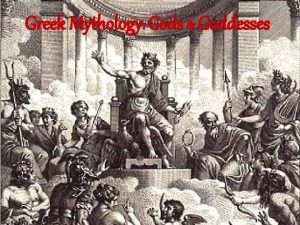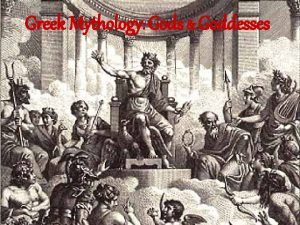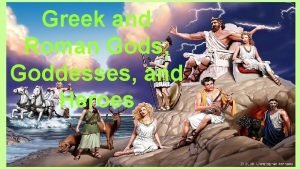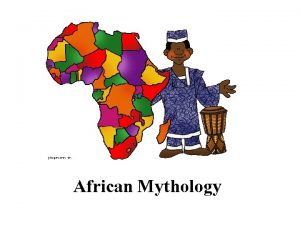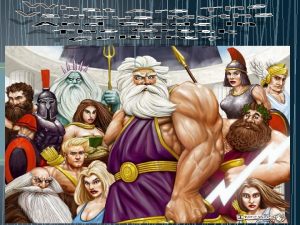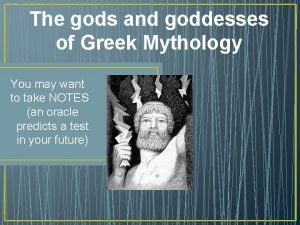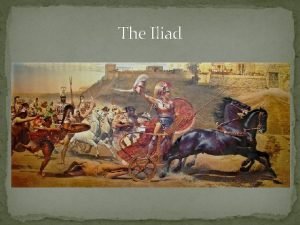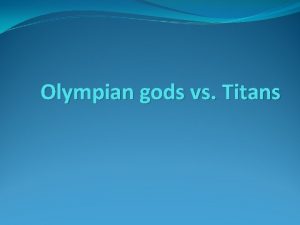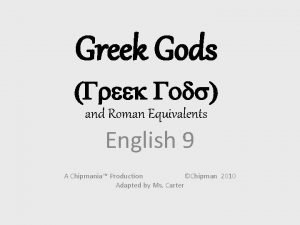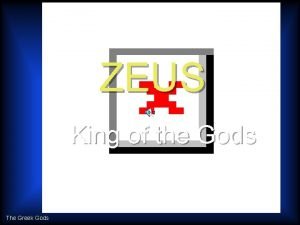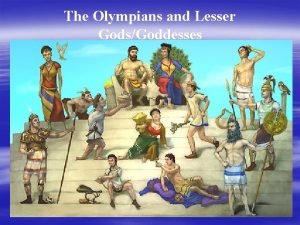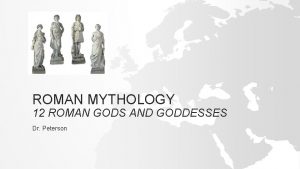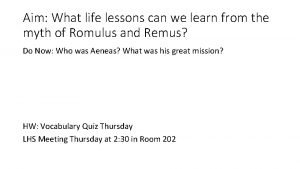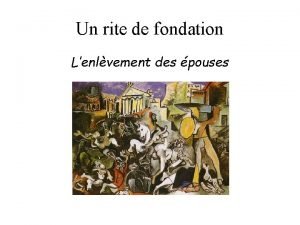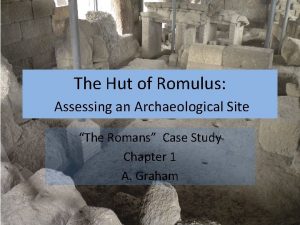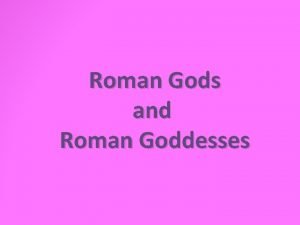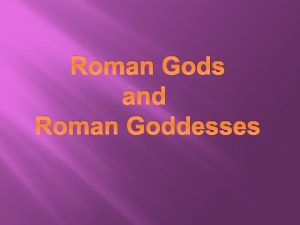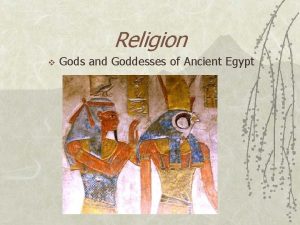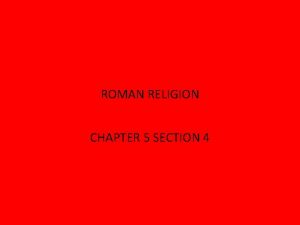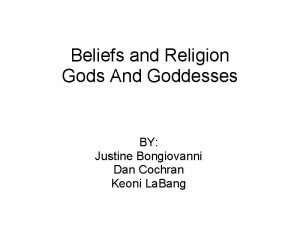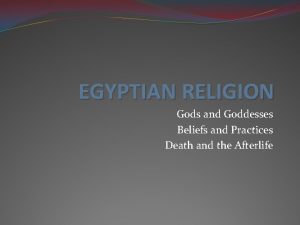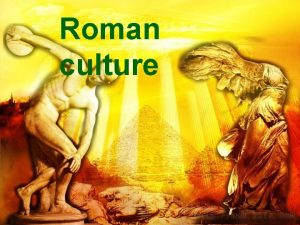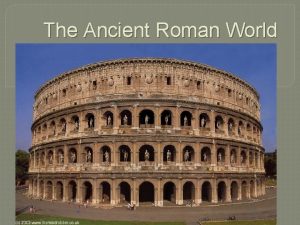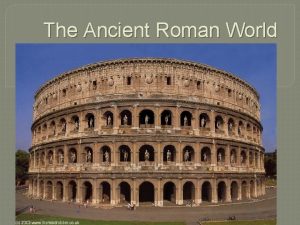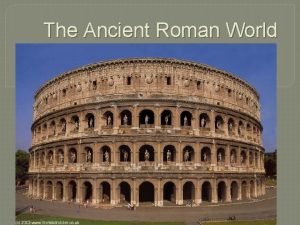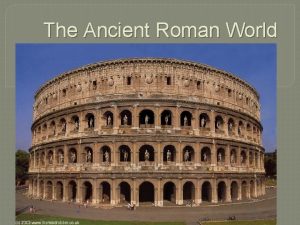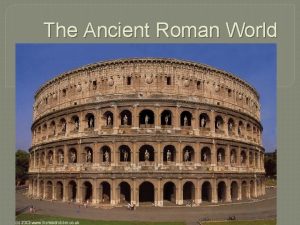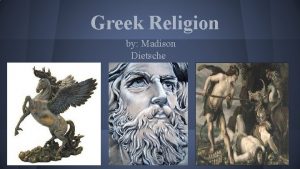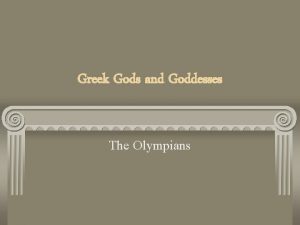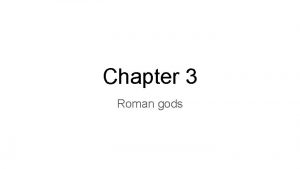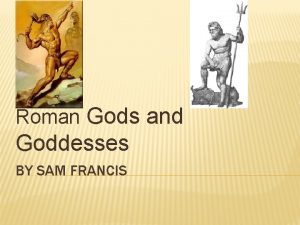ANCIENT ROMAN RELIGION Gods and Goddesses Romulus and



























- Slides: 27

ANCIENT ROMAN RELIGION Gods and Goddesses

Romulus and Remus While the story of Romulus and Remus is one of the central legends of Rome’s early history it doesn’t really tie in to Roman religious beliefs. The story itself was about the founding of the City of Rome but for us, historians, it gives us a glimpse into the values of early Romans: loyalty and justice. Romulus and Remus origin story

Gods and Goddesses Ø Ø Roman religion was influenced by contact with Etruscans and Greeks. Like the Greeks, the Romans adopted a pantheon of supernatural deities. 12 main gods/goddesses, many resembled Greek Gods. People regularly made sacrifices/offerings to appease gods and goddesses.

The Roman Pantheon Jupiter Juno Neptune Minerva Ceres Vesta Apollo Diana Mercury Venus Vulcan Mars Use page 227 of the text to complete your notes on these Gods and Goddesses.

Gods and Goddesses Families kept statues of “Lares” (spirits of family ancestors) in their main living rooms. Ø Ø Ø Spirits were everywhere…in fire, water plants, stones… Offerings: each day the head of household would make an offering of wine and incense on behalf of family.

Religious Beliefs and Practices Ø Ø Like the Greeks, Roman religion was based on Rituals, Traditions rather than on dogma (a clearly defined or written code of beliefs). Festivals were held every month, except for September and November.

Religious Beliefs and Practices Priests: Were elected officials of the state. Ø Ø “Pentifex Maximus” was the chief Priest who supervised other priests. Some gods had designated priests called “Flamens” “Vestal Virgins” were priestesses served the goddess Vesta. Other groups of priests, called “Augurs” looked for signs from the gods.

Religious Beliefs and Practices Ø Ø Ancient Romans believed in Omens , Curses , Spells, Astrology, and Divination. “Divination” is the practice of interpreting the will of the gods through signs and omens such as measuring the size of the sacrificed animals organs.

Ancient Roman Religion Death and Afterlife

Death and Afterlife Ø Ø Ø Like Greeks; the Roman Afterlife did not promise happy immortality. Deceased Romans passed to the underworld to “Hades”. First had to cross River Styx, which separates this world from the next and had to pay “Charon” (The Boatman) Relatives had to put a coin in the mouth of the deceased to pay the toll.

Charon and the River Styx

Death and Afterlife Ø Ø Ø The Funeral The family washed the body – anointed with oils – dressed it in white. Placed on couch for viewing. Mourning lamps were lit. A small Cyprus Tree was placed outside the house. To signify loss, the fire in the hearth was put out.

Death and Afterlife Ø Ø Ø “Sacrifices” were made after a death to purify the house. Poor families buried their dead in a common grave while richer families had a funeral procession, often with professional mourners. Another special sacrifice was made 9 days after the burial for the departed spirit. Every May ceremonies were help to persuade spirits to leave the household and not to haunt it.

Ancient Roman Religion Spread of Christianity

Spread of Christianity

Spread of Christianity Began in the First Century – it was first regarded as a minor Jewish sect (religious group) centered in Jerusalem. Ø Originally based on Judaism a “Monotheistic” religion with one God who governs all aspects of life. Ø God’s word was recorded in a sacred book called “The Torah” with Gods law “Ten Commandments” Ø

Spread of Christianity Ø Ø This religious style “written laws/One God” was unique in the world at this time. Supposedly, around 30 CE, Jesus Christ began teaching and preaching. Jesus Christ came into conflict with high Jewish leaders who felt he could not be the sole agent of God. He also angered Roman officials because many Roman people viewed Jesus as a savior/messiah who came to free the Jews from Roman Rule.

Spread of Christianity - video Ø Previously established religions did not promise equality or eternal happiness in the afterlife. Why would Christianity be viewed as a threat to power control?

Why Christianity Spread Strong Organization Ø Ø Christianity built strong church organization with a hierarchy of leaders. (Bishops/Priests, etc…) Organization became far-reaching Break from Judaism Ø Ø Ø Creates separate church from Judaism. Accepts everyone; slaves, nobles, Jewish or not. (Preached Equality) Everlasting life after death for the

Spread of Christianity Ø Ø Romans were mostly concerned with the message that all were equal in the eyes of God. This contradicted traditional Roman values: Husband over Family Parent over Child Master over Slave Emperor over Citizens

Spread of Christianity

Spread of Christianity p. 229 -231 Ø Ø Roman began prosecuting Christians as early as First Century. Roman Emperor Nero used Christians as a scapegoat for a huge fire that nearly destroyed the city.

Spread of Christianity Ø Ø Christians were considered by many to have angered the Roman gods and goddesses as Christians were blamed for floods/famines and fires, one of which burned down much of Rome in 64 CE. Despite the negative publicity(cannibalism and black magic) many people still converted to Christianity. Ø By 3 rd Century a tenth of Rome was Christian. How did the Emperors deal with the rise of

Persecution Accelerated Then Accepted Emperor Diocletian Ø Ø Considered himself to be God-like and resented the Christians for not worshiping him. Declared official persecution of Christians in 303 CE. Emperor Constantine Ø Ø Became Christian himself. Allowed Christians to practice freely Used state funds to build churches Had soldiers wear Christian monogram on their shield

Spread of Christianity Ø Ø Emperor Theodosius (the successor of Diocletian) made Christianity the official religion of Rome in 380 CE. Christianity became so powerful that it eventually forced Rome to outlaw all other religions.


Thoughts and Questions Did the persecution by the Romans strengthen Christianity and encourage it to spread? Who would the average citizen of Rome find Christianity attractive? How would their daily lives change after they converted?
 12 main greek gods and goddesses
12 main greek gods and goddesses Info
Info Eros family tree
Eros family tree Apollo god family tree
Apollo god family tree Zeus greek roman name
Zeus greek roman name African mythology gods and goddesses
African mythology gods and goddesses Greek gods family trees
Greek gods family trees Uranus god
Uranus god Greek
Greek Shakmet
Shakmet Who is the ruler of all gods
Who is the ruler of all gods What gods did the spartans worship
What gods did the spartans worship Greek mythology family tree
Greek mythology family tree Gods and goddesses in the iliad
Gods and goddesses in the iliad Titan vs olympian
Titan vs olympian Who were the anasazi
Who were the anasazi Dionysus symbol
Dionysus symbol The king of the greek gods
The king of the greek gods Hera realm and symbol
Hera realm and symbol Zeus roman name
Zeus roman name Persepine
Persepine Name of greek goddess
Name of greek goddess Tartarus family tree
Tartarus family tree Romulus and remus moral lesson
Romulus and remus moral lesson Aeneas film
Aeneas film Jubet latin
Jubet latin The hut of romulus
The hut of romulus Romanum imperium a romulo
Romanum imperium a romulo


